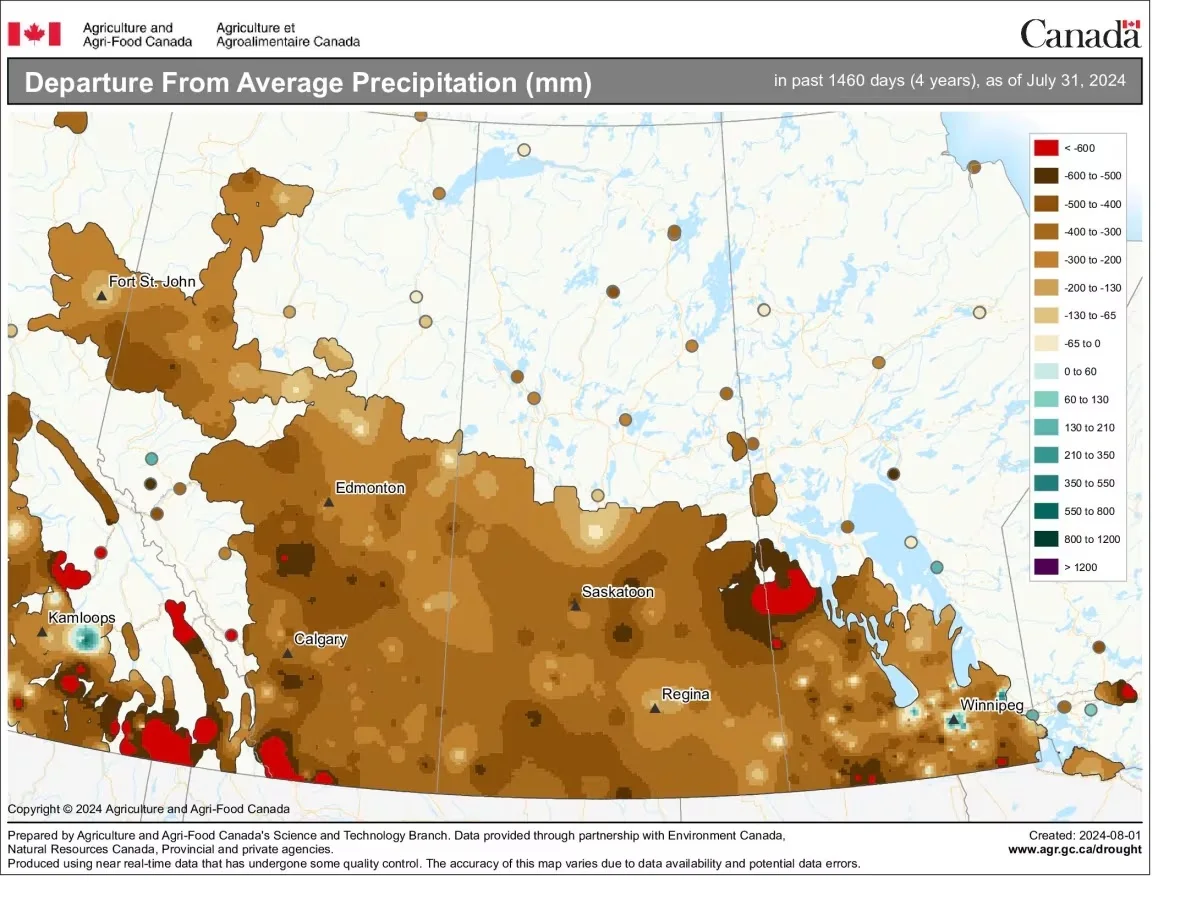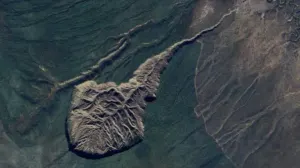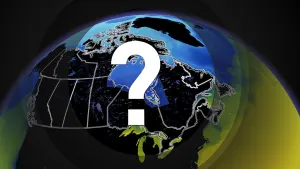
Many Alberta farmers found relief after facing drought, but the story continues
In April at North Paddock Farms, located south of Taber, Alta., Alison Davie and husband Michael were concerned about the months to come.
"It was very, very dry," Davie said in an interview last week. "We thought, oh my goodness."
The farm, part of the St. Mary River Irrigation District, had its water allocation cut in half in April, after a dry winter affected snowpack and reservoir storage.
SEE ALSO: What’s the recipe for a severe drought in Western Canada?
The farm prepared its crop plan accordingly, even seeking to temporarily purchase water allocations within the irrigation district.
And then, May came.
"It just rained and rained and rained," Davie said.
That took the pressure off the irrigation season, especially for wheat crops in the region.
The months that followed illustrated the dynamic nature of farm life.
More rain fell in June, but July brought a return to hot and dry conditions. Scattered storms and showers marked August, though Davie's farm avoided the impacts of hail.

Alison Davie of North Paddock Farms says the operation started its combine about two weeks ago. Soon, the farm will get started on potatoes. All told, the farm is expecting an average crop this year. (Monty Kruger/CBC)
"We have so far been spared. We are looking forward to another harvest season coming up here pretty quick," Davie said.
"Overall, the crops are looking really good."
Timely precipitation changed the fortune of the agricultural season across the irrigation district, which is the biggest in Canada.
The district was able to bump up its water allocation by an inch, said general manager David Westwood.
"I wouldn't say that all our problems are cured. But compared to what we were concerned about, it's actually turned out to be, I would say, an actual adequate or decent year … it really did reverse our fortune," he said.
The current landscape
Drought conditions in Alberta vary across different regions at different times of the year. It means the drought story has landed differently across the province.
Going into the spring, water levels in southern Alberta reservoirs were extremely low, including the Oldman Reservoir, where near-record lows were recorded.
Experts were closely monitoring the situation that was developing in southern Alberta, said Trevor Hadwen, an agroclimate specialist with Agriculture and Agri-Food Canada.
"Water supplies were extremely low. We were really concerned with the soil moisture as we were coming off of a number of years of drought," Hadwen said.

Departure from average precipitation in Alberta, from April 1 to Aug. 26. (Agriculture and Agri-Food Canada)
The spring rainfall allowed for a quick recovery of water supply as well as soil moisture.
While some areas didn't get the desired moisture, overall, conditions improved throughout much of southern Alberta, Hadwen said. The southwest corner of the province is still somewhat below normal, whereas the southeast corner is mostly above normal.
"The driest pocket of the province right now has been the area just northwest of Calgary, from Calgary up to Edmonton, and over to the Hinton area," Hadwen said.
"That area has been the dry pocket this summer, setting up for some poor crops in that region and some continued drought conditions from previous years."
But it doesn't tell the whole story.
There are long-term deficits in much of Alberta, Hadwen noted. The province hasn't seen the type of wet year that would offset dry conditions for quite some time, and large regions still have deficits of more than 300 millimetres over the past four years.
"That makes us vulnerable, right? That allows us to go into drought fairly quickly, or our water supplies to diminish even more rapidly," Hadwen said.

Departure from average precipitation in Alberta over the past four years. (Agriculture and Agri-Food Canada)
Long-term challenges
Many farmers in Alberta are surely relieved at their changed fortunes in what looked like a dire growing year. But challenges tied to Alberta's long-term drought response strategy remain, especially when it comes to its water supply.
For years, there have been concerns that southern Alberta could outpace its water supply — which is tightly regulated — especially amid surging populations and the possibility of more frequent and severe droughts in the future.
"Obviously, that increases the demands on our water supply, not only in terms of municipal usage … but also in terms of agriculture," said Tricia Stadnyk, a professor and Canada Research Chair in hydrologic modelling with the University of Calgary's Schulich School of Engineering.
"We have a commitment within this province to actually expand irrigation-based agriculture. It kind of begs the question, where's that water coming from?"

Tricia Stadnyk, a professor and Canada Research Chair in hydrologic modelling with the University of Calgary's Schulich School of Engineering, says Alberta didn't get enough rainfall to make up for an ongoing deficit. (Monty Kruger/CBC)
In June, a report from the University of Calgary's School of Public Policy stated that tension over water was possible between Calgary and its neighbours as populations grow.
Stadnyk likened the situation to a bank account: if a bank account goes to $10,000 negative, and an individual then receives income of $2,000, they're still in a net-deficit situation.
"Water is no different. Think of it as units stored. And if our environment was lacking units for a three-year period, just because we get a little bit of rain over the short-term doesn't mean that we're out of the danger zone," she said.
"What we know about this particular area of Canada is, not only has it historically been the driest in Canada, it will continue to be dry, if not drier, in the future.
"This is something that Calgarians and Albertans really need to focus on if we want to have the capacity to grow our province and grow our economy."
WATCH: Alberta to invest millions in drought mitigation projects
Thumbnail courtesy of meadowmouse/iStock/Getty Images Plus/Creative #: 1831502892.
The story was originally written by Joel Dryden and published for CBC News.









